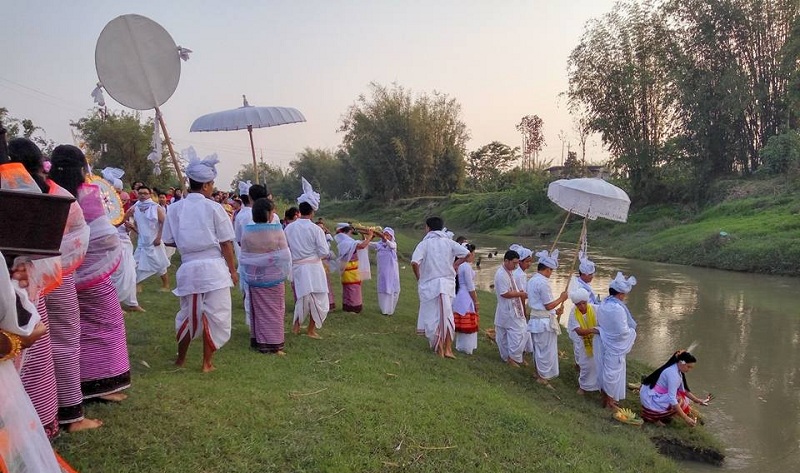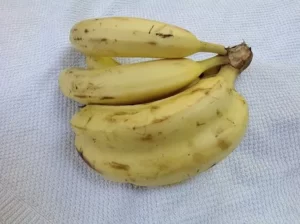In Meitei evolutionary myths, the concept of God is intricately connected to the elements of nature. According to these beliefs, God resides in Heaven, while the Goddess resides in water, enshrining the Earth. This profound connection forms a syncretic relationship between heaven, earth, and water. Water, in particular, holds a special place as the most sacred realm, where God dwells. The ritual known as ‘Lai ikouba‘ exemplifies the spiritual invocation of God from water, seeking their blessings for peace, prosperity, happiness, and oracles to prepare for possible challenges.
In the Meitei culture, ‘Lai Haraoba‘ or the “Cosmic Recreation” rituals commence with ‘Lai ikouba’ as the traditional opening ceremony. These rituals of Lai ikouba are conducted by ‘Amaibi’ priestesses, assisted by ‘Amaiba’ priests. Water, in this context, serves as a cultural symbol deeply embedded in the Meitei community’s identity.
The eighth lunar month, known as ‘Langban,’ usually falling in September-October, is traditionally dedicated to the worship of ancestors and departed souls, a ritual called ‘Langban Heisoi Katpa.’ Families with married daughters would bring fruits, flowers, and ritual items to their ancestral homes, a practice carried out a day ahead or early in the morning.
Those without daughters perform the rituals independently. Female family members play a central role in preparing fruits and ritual items in a specified manner. Elders of the family offer these items to nearby water bodies, particularly rivers and wetlands.
Water is often equated with the concept of motherhood. The Goddess of water, referred to as Ereima or Mother Water, is deeply revered. ‘Loktak Lake,’ a significant water body, is lovingly called ‘Ema’ or Mother. The Meitei community’s struggle to protect and conserve the lake’s ecology has been led by strong women known as Emas or mothers. They consider it their duty to safeguard the lake, as well as their birthright to live with the blessings of Loktak Ema. However, despite their pivotal role in resilience movements, women are often marginalized in negotiations and policy-making.
Apart from narratives celebrating the goodness of water, there exist myths about malevolent water entities. Among the Meitei community, extreme skin rashes and itchiness, known as ‘Erai-khonglai,’ are attributed to a temporary skin infection caused by offending the evil goddess residing in natural drains and ditches. These conditions typically emerge during the onset of the monsoon season. Traditional healers follow a belief system based on appeasement, negotiation, and banishment, offering items called ‘khayom Lakpa‘ in water bodies.
Similar beliefs are found among other ethnic communities like the Maring tribes in Manipur’s Tengnoupal District. They attribute muscle cramps, sickness, or skin rashes to contact with water from streams or sources believed to possess negative energy. These issues tend to spike during the monsoon season. Traditional healers use selected herbs and offerings to address these concerns, and their practices have often proven effective.
The Meitei people also have faith in the Rain god, especially during times of drought or excessive rainfall. ‘Nong Kouba’ involves invoking the rain god through rituals performed by a group of women to bring rain during droughts. Conversely, ‘Nongkhamba’ aims to halt the rain for a specific duration. Certain rituals involve using bamboo baskets tied to poles with negotiation remarks and simple rituals to change the rain’s direction during important occasions.
In cases of drowning and manual rescue operations, the Meitei culture includes the role of ‘Pangan maiba,’ Muslim priests. Drowning incidents, given the abundant water bodies in the region, require community-based rescue operations. However, in more challenging situations, ‘pangan maiba’ is consulted. These experts, whether by coincidence, expertise, or myth, have successfully conducted search operations, demonstrating the ability to stay underwater for extended periods without modern life support equipment.
The younger generation’s relationship with water has evolved with modern amenities like tap water, recreational parks, and picnic spots. Unfortunately, the youth of today are often more engrossed in their phones, leading to a decline in physical activities and outdoor initiatives. Volunteerism to clean polluted water bodies is not as common as preference for picnic spots. Unfortunately, these picnic spots often end up littered with pollution, becoming a concerning aspect of youth culture related to water in Manipur.
Effective water body management has become a critical topic of discussion in Manipur. Challenges such as shrinking wetlands, mismanaged water bodies, polluted rivers, unchecked waste dumping into water bodies, land reclamation, and imbalanced development projects plague the state. Dams constructed for irrigation and water supply in the valley have disrupted natural flows, causing more harm than good. This has adversely affected agricultural productivity, impacting the state’s food sovereignty.
The tribal regions, particularly in Tamenglong, face their set of issues related to rivers being taken for granted in development projects like railway tunnels. These projects obstruct natural streams, affecting water quality and flow. Streams are drying up, adversely impacting the marginalized tribal communities that rely on them.
Water commercialization and conflicts over water sharing are foreseeable challenges in the state’s future if effective management is not implemented. Ethnic crises, deforestation, and depleting catchment areas have contributed to conflicts over water resources. The rise of commercial water supply plants and water tanker businesses has exacerbated water issues, highlighting the inefficiency of public water supply schemes.
Another intriguing water culture among the Meiteis is the use of single-use water bottles. Once a bottle’s cap is opened, it is considered used, discouraging sharing. This trend may be influenced by the COVID-19 pandemic, resulting in the disposal of half-full or quarter-full bottles at social events. Managing discarded water bottles has become a significant challenge.
This article is an Abstractions from NE Water Talk 2023.
Mamta Lukram is a Post Doctoral Fellow and Author of “Manipuri Women Leaders:Their Storyline”.






